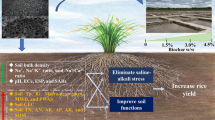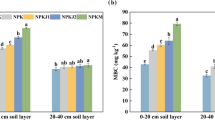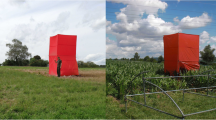Abstract
Croplands are often suffering from sand burial in dry regions of northern China. For studying this phenomenon, we carried out a case study of field experiment including four sand burial levels, i.e. shallow (1–3 cm), moderate (8–12 cm) and deep (15–20 cm) sand burials, and no sand burial (control, CK), in a typical agro-pastoral transitional zone in Naiman Banner of eastern Inner Mongolia. The aim of this study was to assess the impacts of sand burial on maize (Zea mays L.) productivity and the soil quality along a gradient of burial depths. Results showed that there was a strong negative effect of sand burial on maize productivity and soil quality, which significantly declined (P<0.05) under moderate and deep sand burial treatments. In comparison with the CK, the maize yield and above-ground biomass reduced by 47.41% and 39.47%, respectively. The soil silt and clay, soil water, soil organic carbon and total nitrogen contents under deep sand burial decreased by 67.85%, 40.32%, 86.52% and 82.11%, respectively, while microbial biomass carbon, microbial abundance and enzyme activity decreased by 89.78%, 42.28%–79.66% and 69.51%–97.71%, respectively. There was no significant effect on crop productivity and soil quality with shallow sand burial treatment. The correlations analysis showed that there was significant positive correlations of both maize yield and above-ground biomass with soil silt and clay, soil organic carbon and total nitrogen contents, pH, electrical conductivity, soil water content, microbial abundance and biomass and all tested soil enzyme activities. Stepwise regression analysis indicated that soil water and total nitrogen contents, urease, cellobiohydrolase and peroxidase activities were key determining factors for maize productivity. This combination of factors explains reason of the decreased maize productivity with deep sand burial. We found that degradation of cropland as a result of sand burial changed soil physical-chemical properties and soil enzyme activities in the plow layer, and decreased overall maize productivity. Furthermore, decreased soil enzyme activity was a better indicator to predict sandy cropland degradation.
Similar content being viewed by others
References
Acosta-Martínez V, Klose S, Zobeck T M. 2003. Enzyme activities in semiarid soils under conservation reserve program, native rangeland, and cropland. Journal of Plant Nutrition and Soil Science, 166(6): 699–707.
Aon M A, Colaneri A C. 2001. II. Temporal and spatial evolution of enzymatic activities and physico-chemical properties in an agricultural soil. Applied Soil Eclogy, 18(3): 255–270.
Bach E M, Baer S G, Meyer C K, et al. 2010. Soil texture affects soil microbial and structural recovery during grassland restoration. Soil Biology and Biochemistry, 42(12): 2182–2191.
Böhme L, Böhme F. 2006. Soil microbiological and biochemical properties affected by plant growth and different long-term fertilisation. European Journal of Soil Biology, 42(1): 1–12.
Brown J F. 1997. Effects of experimental burial on survival, growth, and resource allocation of three species of dune plants. Journal of Ecology, 85(2):151–158.
Burns R G. 1978. Soil Enzymes. London: Academic Press.
Chapin III F S, Matson P A, Vitousek P M. 2002. Principles of Terrestrial Ecosystem Ecology. New York: Springer.
Collins C H, Lyne P M, Grange J M. 1995. Microbiological Methods (7th ed.). Oxford: Butterworth-Heinemann Ltd.
Degens B P, Sparling G P, Abbott L K. 1996. Increasing the length of hyphae in a sandy soil increases the amount of water-stable aggregates. Applied Soil Ecology, 3(2): 149–159.
Garbisu C, Alkorta I, Epelde L. 2011. Assessment of soil quality using microbial properties and attributes of ecological relevance. Applied Soil Ecology, 49(1): 1–4.
García-Orenes F, Guerrero C, Roldán A, et al. 2010. Soil microbial biomass and activity under different agricultural management systems in a semiarid Mediterranean agroecosystem. Soil and Tillage Research, 109(2): 110–115.
Gomes L, Arrúe J L, López M V, et al. 2003. Wind erosion in a semiarid agricultural area of Spain: the WELSONS project. Catena, 52(3–4): 235–256.
Gómez-Sagasti M T, Alkorta I, Becerril J M, et al. 2012. Microbial monitoring of the recovery of soil quality during heavy metal phytoremediation. Water, Air, & Soil Pollution, 223(6): 3249–3262.
Guan S Y. 1986. Research Methods on Soil Enzymes. Beijing: Chinese Agriculture Press. (in Chinese)
Hennessy J T, Kies B, Gibbens R P, et al. 1986. Soil sorting by forty-five years of wind erosion on a southern New Mexico range. Soil Science Society of America Journal, 50(2): 391–394.
Institute of Soil Sciences, CAS. 1978. Physical and Chemical Analysis Methods of Soils. Shanghai: Shanghai Science Technology Press. (in Chinese)
Kandeler E, Tscherko D, Spiegel H. 1999. Long-term monitoring of microbial biomass, N mineralisation and enzyme activities of a Chernozem under different tillage management. Biology and Fertility of Soils, 28(4): 343–351.
Karlen D L, Mausbach M J, Doran J W, et al. 1997. Soil quality: A concept, definition, and framework for evaluation (a guest editorial). Soil Science Society of America Journal, 61: 4–10.
Larney F J, Bullock M S, Janzen H H, et al. 1998. Wind erosion effects on nutrient redistribution and soil productivity. Journal of Soil and Water Conservation, 53(2): 133–140.
Li F R, Zhao L Y, Zhang H, et al. 2004. Wind erosion and airborne dust deposition in farmland during spring in the Horqin Sandy Land of eastern Inner Mongolia, China. Soil and Tillage Research, 75(74): 121–130.
Li Y Q, Han J J, Wang S K, et al. 2014. Soil organic carbon and total nitrogen storage under different land uses in the Naiman Banner, a semiarid degraded region of northern China. Canadian Journal of Soil Science, 94(1): 9–20.
Moore J M, Klose S, Tabatabai M A. 2000. Soil microbial biomass carbon and nitrogen as affected by cropping systems. Biology and Fertility of Soils, 31(3–4): 200–210.
Nelson D W, Sommers L E. 1982. Total carbon, organic carbon, and organic matter. In: Albert L. Methods of Soil Analysis. Part 2. Chemical and Microbiological Properties. Madison: Soil Science Society of America.
Pajares S, Gallardo J F, Masciandaro G, et al. 2011. Enzyme activity as an indicator of soil quality changes in degraded cultivated Acrisols in the Mexican Trans-volcanic Belt. Land Degradation & Development, 22(3): 373–381.
Paul B K, Vanlauwe B, Ayuke F, et al. 2013. Medium-term impact of tillage and residue management on soil aggregate stability, soil carbon and crop productivity. Agriculture, Ecosystems & Environment, 164(1): 14–22.
Powlson D S, Prookes P C, Christensen B T. 1987. Measurement of soil microbial biomass provides an early indication of changes in total soil organic matter due to straw incorporation. Soil Biology and Biochemistry, 19(2): 159–164.
Qu H, Zhao H L, Zhou R L, et al. 2012. Effects of sand burial stress on maize (Zea mays L.) growth and physiological responses. Australian Journal of Crop Science, 6: 869–876.
Schloter M, Dilly O, Munch J C. 2003. Indicators for evaluating soil quality. Agriculture, Ecosystems & Environment, 98(1–3): 255–262.
Sinsabaugh R L, Lauber C L, Weintraub M N, et al. 2008. Stoichiometry of soil enzyme activity at global scale. Ecology Letters, 11(11): 1252–1264.
Stenberg B. 1999. Monitoring soil quality of arable land: microbiological indicators. Acta Agriculturae Scandinavica, Section B–Plant and Soil Science, 49(1): 1–24.
Su Y Z, Zhao H L, Zhao W Z, et al. 2004. Fractal features of soil particle size distribution and the implication for indicating desertification. Geoderma, 122(1): 43–49.
Tabatabai M A. 1982. Soil enzymes. In: Albert L. Methods of Soil Analysis. Part 2. Chemical and Microbiological Properties. Madison: Soil Science Society of America, 903–947.
Trasar-Cepeda C, Leirós M C, Gil-Sotres F. 2000. Biochemical properties of acid soils under climax vegetation (Atlantic oakwood) in an area of the European temperate-humid zone (Galicia, NW Spain): specific parameters. Soil Biology and Biochemistry, 32: 747–755.
Vance E D, Brookes P C, Jenkinson D S. 1987. An extraction method for measuring soil microbial biomass C. Soil Biology and Biochemistry, 19(6): 703–707.
Wezel A, Rajot J L, Herbrig C. 2000. Influence of shrubs on soil characteristics and their function in Sahelian agro-ecosystems in semi-arid Niger. Journal of Arid Environments, 44(4): 383–398.
Xu G H, Zheng H Y. 1986. A Manual of Soil Microbial Analysis Methods. Beijing: Agriculture Press. (in Chinese)
Zhao H L, Zhou R L, Zhang T H, et al. 2006. Effects of desertification on soil and crop growth properties in Horqin sandy cropland of Inner Mongolia, north China. Soil and Tillage Research, 87(2): 175–185.
Zhao H L, Zhou R L, Drake S. 2007a. Effects of aeolian deposition on soil properties and crop growth in sandy soils of northern China. Geoderma, 142(3–4): 342–348.
Zhao H L, Zhao X Y, Zhang T H, et al. 2007b. Bioprocess of Desertification and Restoration Mechanism of Degraded Vegetation. Beijing: Science Press. (in Chinese)
Zhao X Y, Wang S K, Luo Y Y, et al. 2015. Toward sustainable desertification reversion: A case study in Horqin Sandy Land of northern China. Sciences in Cold and Arid Regions, 7(1): 23–28.
Zhu Z D, Chen G T. 1994. Sandy Desertification in China. Beijing: Science Press. (in Chinese)
Author information
Authors and Affiliations
Corresponding author
Rights and permissions
About this article
Cite this article
Wang, S., Zhao, X., Zhao, H. et al. Impact of sand burial on maize (Zea mays L.) productivity and soil quality in Horqin sandy cropland, Inner Mongolia, China. J. Arid Land 8, 569–578 (2016). https://doi.org/10.1007/s40333-016-0011-1
Received:
Revised:
Accepted:
Published:
Issue Date:
DOI: https://doi.org/10.1007/s40333-016-0011-1




